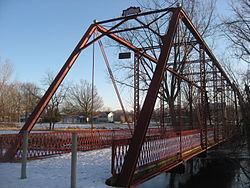Area less than one acre Architectural style Pratt through truss Opened 1897 | Built 1897 (1897) NRHP Reference # 96001546 Added to NRHP 2 January 1997 | |
 | ||
Nearest city Junction of Old U.S. Route 30 and Road 350 W west of Warsaw, across the Tippecanoe River, Harrison Township and Wayne Township, Kosciusko County, Indiana Built by Bellefontaine Bridge & Iron Company | ||
Chinworth bridge 1 15 11
The bridge is significant locally as the only Pratt through truss bridge remaining in Kosciusko County, and is important regionally as one of the few surviving spans built by the Bellefontaine Bridge and Iron Company.
Contents
Just west of the bridge was a ford across the Tippecanoe River. The Yellowstone Trail passed on the south side of the river. A marker has been maintained at this location. A post with yellows bands and a "Y" in a black circle In 1884, a new bridge across the Tippecanoe River was requested to connect Warsaw, on the south with a to Atwood and Etna Green on the north. It crossed the property of Robert Chinworth. Capt. David Braden working for the Bellefontaine Bridge and Iron Company agreed to erect a 140 feet (43 m) span over the Tippecanoe River, at a total cost of $2520.00. The bridge opened in August, 1897. In 1924, with the construction of U.S. 30 the Chinworth Bridge was bypassed as it could not handle modern vehicular traffic. The Indiana State Highway Commission, created Tippecanoe Rest Area adjacent to the Chinworth Bridge.
In 1975, the enhanced 4-lane U.S. 30 was located north of the Chinworth Bridge. The bridge was closed to all vehicular traffic at that time. In July the Kosciusko County Historical Society obtained the Tippecanoe Rest Park from the State Highway Department. The KCHS dedicated the bridge as a historic landmark on July 6, 1975.
Description
The Chinworth Bridge was built by the Bellefontaine Bridge and Iron Company of Bellefontaine, Ohio. It is a 140 feet (43 m) Pratt through truss. The trusses has eight panels, each 17.5 feet (5.3 m) long, set on abutments of cut stone. The southern abutment has been altered over the years.
The trusses have horizontal and parallel top and bottom chords, 24 feet (7.3 m) apart with inclined posts at each end. Diagonals are designed for tension with greater stress expected toward the span's end. A single counterbrace in the third panel and a pair in the fourth, each of 0.75 inches (1.9 cm) round rods with turnbuckles.
Bracing at the upper chord and at the lower chord adds strength. To protect against swaying, a round iron rod runs diagonally from one truss to the other.
I-floor beams carry the span's deck. Sets of stringers carry the 14 feet (4.3 m) timber running surface. The timbers were covered in 1927 by a bituminous coating. A latticed guardrail runs the length of each side of the deck. The bridge allows a clearance of 19 feet (5.8 m).
Significance
Chinworth Bridge is an example of a Pratt through truss bridge. Patented in 1844 Caleb and Thomas Pratt, the truss has vertical elements acting in compression and diagonal components acting in tension. A pin-connected Pratt through truss is "representative of perhaps the most common type of early-20th century truss bridges."
